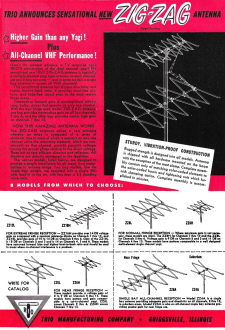|
October 1952 Radio-Electronics
 [Table of Contents] [Table of Contents]
Wax nostalgic about and learn from the history of early electronics.
See articles from Radio-Electronics,
published 1930-1988. All copyrights hereby acknowledged.
|
This advertisement for
a Zig-Zag Antenna, offered by Trio Manufacturing, appearing in a 1952 issue of
Radio-Electronics magazine, states "patent pending." When I looked up "zig-zag
antenna" at the U.S. Patent and Trademark Office (USPTO), the earliest assignment
I could find for that configuration was
US3213457A, "Zig-zag
antenna," designed by John W. Carr and assigned to Lockheed Corporation, in 1961.
Maybe Trio never received a patent, or my search wasn't thorough enough. The claim
to fame from Trio's design is that the zig-zag pattern consisted of various element
lengths that resonated on specific channels while all others acted as parasitic
elements. I don't know if it is coincidence or intention (probably the latter),
but there are twelve sections that might correspond to channels 2 through 13. There
are not many (if any) zig-zag antennas being sold by companies today for amateur
or other uses. It evidently was just another fad to have something different from
all the rest - and there were lots of unique TV antenna configurations back in the
day which promised to pull in far-away stations, reduce ghosts, noise, etc.
Trio Manufacturing Company Zig-Zag Antenna
 Trio Announces Sensational New Zig-Zag Antenna Trio Announces Sensational New Zig-Zag Antenna
Patent Pending
Higher Gain than any Yagi!
Plus
All-Channel VHF Performance!
Here's the greatest advance in TV antennas since Trio's introduction of the dual
channel yagi! The sensational new Trio Zig-Zag antenna is basically a multiple element
yagi type antenna on each channel, yet one 2-bay antenna - and in some models a
single bay antenna - covers all VHF channels!
This sensational antenna has sharper directivity and higher front-to-back ratio.
It provides snow-free pictures, and fade-free sound even in the most remote fringe
areas.
Tremendous forward gain is accomplished without long, bulky, arrays that operate
on only one channel. With the new fringe area model Zig-Zag antenna, one bay provides
tremendous gain on all low channels, 2 thru 6, and the other bay provides similar
high gain on channels 7 thru 13.
How This Amazing Antenna Works
Trio Zig-Zag antennas utilize a new principle whereby an array is composed of
a series of elements, one or more of which is resonant on any one channel while
the remaining elements, which are non-resonant on that channel, provide parasitic
voltages having the proper phase relative to the direct voltage. These act as very
efficient directors and reflectors. All elements are directly connected to the feed-line.
The various models, listed below, are designed to provide a simple installation
for all areas, from metropolitan to extreme fringe. Two bay models, like the single
bay models, are operated with a single 300 ohm lead-in to the set, with less than
a 3:1 standing wave ratio.
Sturdy, Vibration-Proof Construction
Rugged strength is designed into all models. Antenna is shipped with all hardware
mounted on the boom with the exception of the mast clamp. Complete assembly consists
only of matching color-coded elements to the color-coded boom and tightening nuts
which furnish clamping action. Complete assembly is accomplished in minutes.
For Extreme Fringe Reception - ZZ16H provides over 14 DB voltage
gain as compared with a resonant reference dipole on Channel. 7 thru 13; and ZZ12L
provide. gain of 12 to 14 DB on Channel. 2 thru 6. Gain of the ZZ12L is 12 DB on
Channels 2 and 3 and is 14 on Channels 4, 5 and 6. These models have narrowest forward
lobe and highest front-to-back ratio and should be used in areas where co-channel
interference is a problem.
For Near Fringe Reception - These models provide a voltage gain
of 8 to 9 DB on Channels 2 thru 13. These models have pattern and gain comparable
to a cut-to-channel yagi. ZZ6L cove" Channels 2 thru 6. ZZ6H covers Channels 7 thru
f 13.
For Normal Fringe Reception - Where maximum gain is not necessary,
these models are ideal. The ZZ8H for Channels 7 thru 13 and the ZZ8L for Channels
2 thru 6. Voltage gain is 9 DB on Channels 2 and 3 and 11 DB on Channels 4 thru
13, These models have patterns comparable to a well designed multi-element single
channel yagi.
Single Bay All-Channel Reception - Model ZZ4A is a single bay
antenna providing adequate gain and directivity on all channels, 2 thru 13, in suburban
areas. Model ZZ6A is also an all-channel single bay antenna providing greater gain
for near fringe use.
Trio Manufacturing Company • Griggsville, Illinois
Posted June 27, 2022
|










